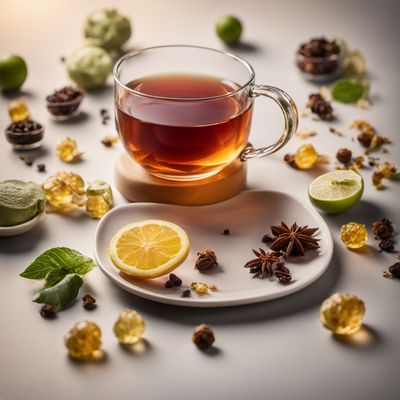
Ingredient
Tea beverages
The Art of Tea: Exploring the World of Infusions
Tea beverages encompass a vast array of options, including black, green, white, oolong, and herbal teas. They are made by infusing the leaves, flowers, or roots of various plants in hot water. With diverse flavors, aromas, and health properties, tea beverages have become an integral part of cultures worldwide. They can range from delicate and floral to robust and earthy, with variations in taste, color, and caffeine content.
Origins and history
Tea has a rich history that dates back thousands of years. Originating in China, it was initially consumed for its medicinal properties before evolving into a popular beverage. Tea spread to Japan, India, and other parts of the world, each region developing its unique tea culture. Today, tea is enjoyed globally, with different countries having their own tea traditions and rituals.
Nutritional information
Tea beverages are known for their antioxidant properties and potential health benefits. They are often low in calories and can provide hydration, along with essential vitamins, minerals, and polyphenols. The exact nutritional content varies depending on the type of tea and any added ingredients.
Allergens
Tea beverages are generally safe for consumption, but some individuals may be allergic to specific types of tea or herbal ingredients. Common allergens associated with tea include caffeine and certain herbal additives. It is essential to read labels and consult with a healthcare professional if you have any known allergies or sensitivities.
How to select
When selecting tea beverages, consider the quality of the tea leaves or herbal ingredients. Look for whole leaves or large pieces, as they tend to offer better flavor and aroma. Avoid tea bags or blends with excessive dust or fannings, as they may result in a weaker brew. Additionally, opt for organic or sustainably sourced teas whenever possible to support ethical and environmentally friendly practices.
Storage recommendations
To maintain the freshness and quality of tea beverages, store them in airtight containers away from light, heat, moisture, and strong odors. Keep them in a cool, dry place, such as a pantry or cupboard. Avoid storing tea near spices or other strong-smelling ingredients, as they can affect the flavor of the tea.
How to produce
Tea can be grown in various climates, depending on the type of tea plant. Amateur gardeners can cultivate tea by starting with young tea plants or seeds in suitable soil and providing adequate sunlight, water, and care. However, tea production requires specific expertise and conditions, making it more feasible on a larger scale or in specialized tea gardens.
Preparation tips
To prepare tea beverages, start by heating water to the appropriate temperature for the specific type of tea. Steep the tea leaves or herbal ingredients in the hot water for the recommended time, usually 2-5 minutes. Adjust the steeping time based on personal preference for a stronger or milder flavor. Serve the tea hot or over ice, and add sweeteners, milk, or lemon as desired. Experiment with different tea blends and brewing techniques to discover your preferred flavors.
Culinary uses
Tea beverages are incredibly versatile and can be used in various culinary applications. They can be enjoyed on their own or used as a base for refreshing iced teas, cocktails, or mocktails. Tea can also be incorporated into baked goods, desserts, marinades, and sauces, adding unique flavors and aromas to dishes. Additionally, herbal teas are often used for their medicinal properties and are infused into remedies or natural skincare products.
Availability
Tea is widely available in most regions around the world. Different types of tea may be more prevalent in specific countries or cultures. For example, green tea is commonly consumed in East Asia, while black tea is popular in Western countries. Herbal teas can be found globally, with each region having its traditional herbal infusions.
More ingredients from this category

Non-fermented tea, infusion
The Art of Tea Infusion

Fermented tea infusion
The Elixir of Health: Fermented Tea Infusion

Tea infusion with added flavouring ingredients
A Symphony of Flavors: Exploring the World of Infused Teas

Tea, decaffeinated, infusion
The Soothing Elixir: Decaffeinated Tea Infusion
Recipes using Tea beverages

Assamese-style Brasillé
Assamese Delight: A Fusion of French and Assamese Flavors

Beef Bourguignon
Hearty Russian-style Beef Stew

Japanese-style Breakfast
Harmony of Flavors: A Japanese Twist on the Classic English Breakfast

Indo-inspired Tiramisù
Spiced Chai Tiramisù: A Fusion of Italian and Indo Flavors

Hubei-style Chazuke
Savory Rice Soup with a Hubei Twist

Taiwanese Tiramisù
Bubble Tea Tiramisù: A Taiwanese Twist on the Classic Italian Dessert

Taiwanese-style Sachertorte
Taiwanese Black Tea Chocolate Cake

Montserrat-style Spiced Shrimp with Herbal Infusion
Caribbean Delight: Montserrat-style Spiced Shrimp with a Herbal Twist

Classic British Afternoon Tea
Indulge in the Quintessential British Afternoon Tea Experience